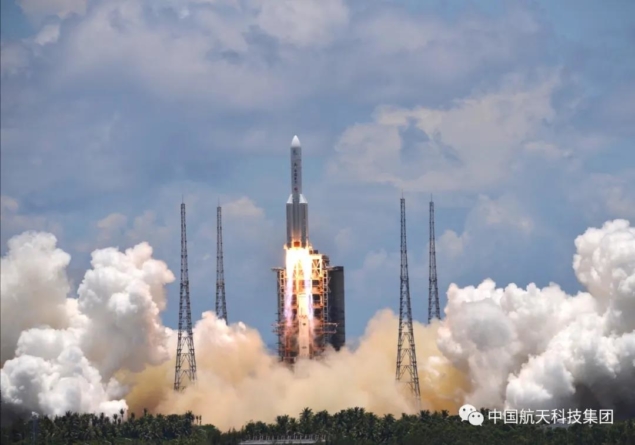
China has launched its first independent mission to Mars with the uncrewed craft expected to look for clues of water-ice, past life and study the evolution of our neighbouring planet. At 12:41 p.m. Beijing time today, Tianwen-1 (“heavenly questions”) took off atop a Long March 5 rocket from Wenchang Satellite Launch Center in southern China. The craft contains an orbiter as well as a lander and rover and is expected to reach Mars in February.
[Tianwen-1 is] a milestone mission for China’s aerospace to go deeper into space Yansheng Wu
China Aerospace Science and Technology Corporation (CASC) – the country’s main space contractor – said that the launch went smoothly and about 45 minutes later the probe entered the planned Earth–Mars transfer orbit. “[Tianwen-1 is] a milestone mission for China’s aerospace to go deeper into space,” noted mission deputy commander Yansheng Wu in a statement.
Onboard Tianwen-1 are 13 scientific instruments – seven on the orbiter and six on the rover – that will aim to obtain comprehensive, first-hand data about the planet including its magnetosphere and atmosphere as well as surface and subsurface geological structures. Some instruments on Tianwen-1 are similar to those used in previous NASA missions, such as a surface component detector that fires a laser to vaporize rock surfaces and measure chemical elements as well as ground-penetrating radar to detect global water-ice distribution from orbit.
Confidence boost
Landing on Mars will be China’s next challenge. Despite its recent successes with a Moon landing, China has never landed through a thin atmosphere like that on Mars. To do so, Tianwen-1 will use a parachute and a “retro-engine” to slow down its descent. At about 100 m above the surface, Tianwen-1 will briefly pause firing its retro engines to take snapshots of the landing area to calculate the best landing spot. To manage this aspect of the landing, the craft will use an autonomous obstacle avoidance technology, which was originally developed for China’s lunar missions. It is hoped that the lander and rover will touch down in a region called Utopia Planitia, which is a largely flat impact basin but scientifically interesting with potential water-ice underneath.
China’s first attempt to reach Mars was in 2011 when an orbiter piggybacked on a Russian mission to the Martian moon Phobos. However, the launch failed and China began to come up with a new mission. The successful launch of Tianwen-1 greatly boosts confidence in the Long March 5 rocket – China’s biggest heavy-lifting launcher – after it experienced a major failure in 2017 due to a first-stage engine problem. This success has now paved the way for a sample-return mission to the Moon by the end of the year as well as the launch of the core module of the Chinese space station early next year.
Tianwen-1 is one of three missions heading to Mars this month. On Monday, the United Arab Emirates successfully launched its Mars-bound Hope orbiter from Japan while on 30 July NASA is expected to launch its Mars 2020 mission, which includes the Perseverance rover and a Mars helicopter called Ingenuity.
- navigation
- Categories
- Contact
Add: 6F,building 5,CEC Park,Caotan 10th road,Xi'an,China
Post Code:710018
Tel: +86-29-88868880 Fax: +86-29-89348169
E-mail:info@satpro.com
Germany
Add: Dorftr. 1i, 16761, Hennigsdorf, Brandenburg, Germany
Tel: +4933022079295
- QR CODE

NEEQ:831244






